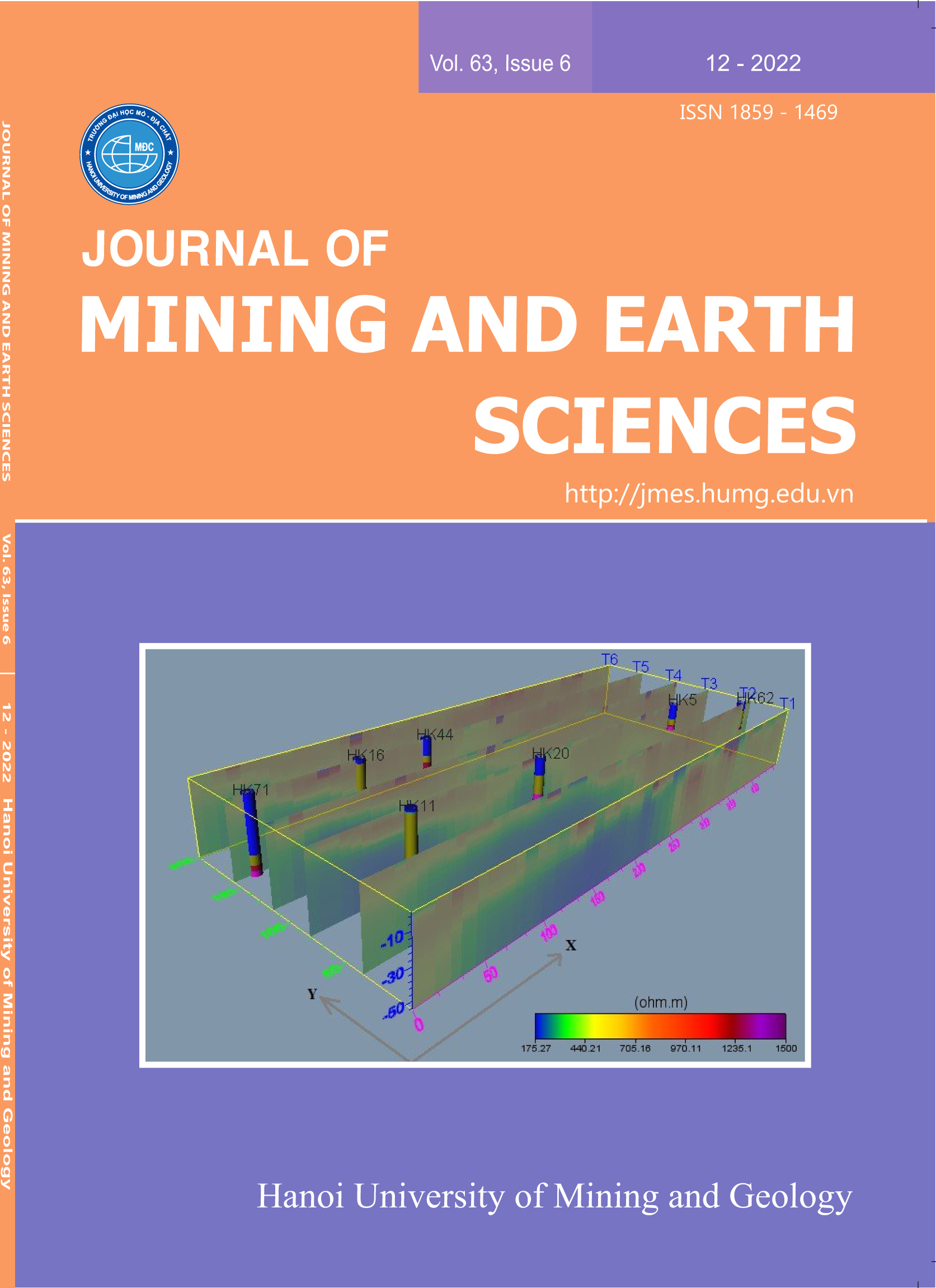Reasonable exploitation solution for longwall in Seam L7 at East Side to ensure the stability of G9 surface works of Mong Duong Coal Mine
Tóm tắt
When exploiting the working face located under the surface works need to be protected, it may lead to potential risks that cause unsafety and effect for the stability of those works. The degree of influence on the surface works depends on many factors, including the exploitation technology factor. It is always necessary to study and evaluate the impact of mining on the surface works to propose appropriate technical solutions and mining technology to ensure the safety during mining process. Through the field study at Mong Duong Coal Mine, finding a reasonable mining solution for the longwall in Seam L7 at East Side is important to ensure the stability of the G9 surface works. These works include a coal storage, and some construction works of level 4 houses, equipment and machinery for coal transportation and their total weight is estimated about 200,000 tons. Research methods used include numerical modeling method combined with comparative data analysis method. The authors have determined the heights of the collapse zone and fracture zone corresponding to the face advance of the longwall and the degree of influence on the surface works. These are considered as a basis for choosing a reasonable mining solution for the condition of the longwall to ensure the stability of the surface works. The above methods are applied to the condition of the longwall in Seam L7 at East Side of Mong Duong Coal Mine and find a reasonable exploitation for the longwall in Seam L7 with a cutting height of 2.2 m and recovering 100% of top coal (corresponding to 0.8 m). When the longwall is exploited in the strike direction to 140 m, the G9 surface works remain unaffected. When the longwall is exploited in the strike direction of 160 m onward, those works will be affected. The paper’s results are used as a basis for Mong Duong Coal Mine to choose a mining solution and to timely adjust the mining solution of the longwall in Seam L7, ensuring efficiency and stability for G9 surface works.Tài liệu tham khảo
Acharyya, R., & Dey, A. (2017). Finite element investigation of the bearing capacity of square footings resting on sloping ground. INAE Lett., 2, 97-105.
Al-Aghbari, M.Y., & Dutta, R.K. (2008). Performance of square footing with structural skirt resting on sand. Geomech. Geoengin. Int. J., 3, 271-277.
Al-Aghbari, M.Y., & Mohamedzein, Y. A. (2004). Model testing of strip footings with structural skirts. Proc. Inst. Civ. Eng.-Ground Improv., 8, 171-177.
Bhattacharjee, A., Mittal, S., Krishna, A. (2011). Bearing capacity improvement of square footing by micropiles. Int. J. Geotech. Eng., 5, 113-118.
Bruce, D.A., Dimillio, A.F., & Juran, I. (1997). Micropiles: the state of practice part 1: characteristics, definitions and classifications. Proc. Inst. Civ. Eng.-Ground Improv.,1, 25–35.
Esmaeili, M., Nik, M.G., Khayyer, F. (2013). Experimental and numerical study of micropiles to reinforce high railway embankments. Int. J. Geomech., 13, 729–744.
Hwang, T.H., Kim, K.H., & Shin, J.H. (2017). Effective installation of micropiles to enhance bearing capacity of micropiled raft. Soils Found., 57, 36-49.
Juran, I., Bruce, D.A., Dimillio, A., & Benslimane, A. (1999). Micropiles: the state of practice. Part II: design of single micropiles and groups and networks of micropiles. Proc. Inst. Civ. Eng.-Ground Improv., 3, 89-110.
Lee, T.-H., Chul, I.J., Kim, C. (2016). A Method for reinforcing the ground adjacent to the footing using micropiles. Mar. Georesources Geotechnol., 34, 341-355.
Liu, J., Xu, T., Wang, X. (2021). Seismic Behavior and Design of Concrete-Filled Thin-Walled Steel Tube Column-to-Foundation Connections. J. Struct. Eng., 147, 04021072.
Momeni, E., Nazir, R., Armaghani, D.J., & Sohaie, H. (2015). Bearing capacity of precast thin-walled foundation in sand. Proc. Inst. Civ. Eng.-Geotech. Eng., 168, 539-550.
Raj, D., Bharathi, M. (2013). Bearing capacity of shallow foundation on slope: a review, in: Proceedings of the 4th ICSMFE.
Report on soil investigation. (2019). No: 2019.ĐC.TKKT.10.Viet Delta Consultancy., JSC.
Shah, I.A., Zaid, M., Farooqi, M.A., & Ali, K. (2021). Numerical Study on Micropile Stabilized Foundation in Flyash. Indian Geotech. J., 51, 1099–1106.
Terzaghi, K., Peck, R.B., & Mesri, G. (1996). Soil mechanics in engineering practice. John Wiley & Sons.
Vietnam Ministry of Transport. (2016). Research on the application of micropiles for transportation structures in Vietnam. Institute of Transport Science and Technology.
Xiang, Y., Long, W., & Shi, H. (2015). Analysis on horizontal bearing capacity based on catastrophe theory of anti-slide micropiles, in: ISRM VietRock International Workshop. OnePetro.


